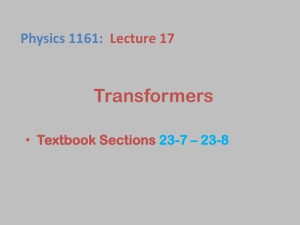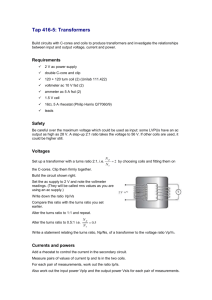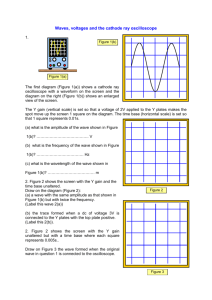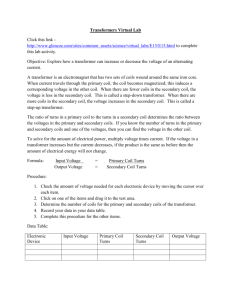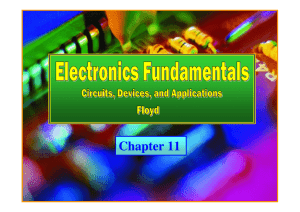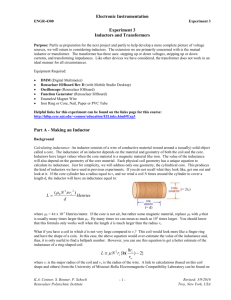Test 1 Study Guide
advertisement
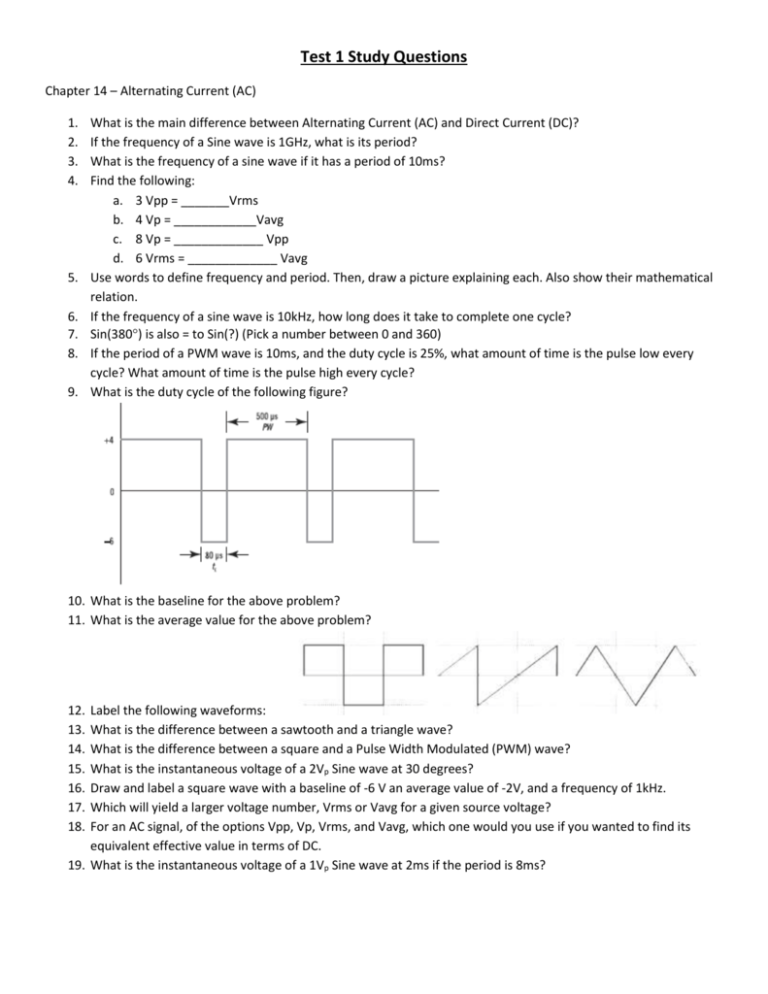
Test 1 Study Questions Chapter 14 – Alternating Current (AC) 1. 2. 3. 4. 5. 6. 7. 8. 9. What is the main difference between Alternating Current (AC) and Direct Current (DC)? If the frequency of a Sine wave is 1GHz, what is its period? What is the frequency of a sine wave if it has a period of 10ms? Find the following: a. 3 Vpp = _______Vrms b. 4 Vp = ____________Vavg c. 8 Vp = _____________ Vpp d. 6 Vrms = _____________ Vavg Use words to define frequency and period. Then, draw a picture explaining each. Also show their mathematical relation. If the frequency of a sine wave is 10kHz, how long does it take to complete one cycle? Sin(380) is also = to Sin(?) (Pick a number between 0 and 360) If the period of a PWM wave is 10ms, and the duty cycle is 25%, what amount of time is the pulse low every cycle? What amount of time is the pulse high every cycle? What is the duty cycle of the following figure? 10. What is the baseline for the above problem? 11. What is the average value for the above problem? 12. 13. 14. 15. 16. 17. 18. Label the following waveforms: What is the difference between a sawtooth and a triangle wave? What is the difference between a square and a Pulse Width Modulated (PWM) wave? What is the instantaneous voltage of a 2Vp Sine wave at 30 degrees? Draw and label a square wave with a baseline of -6 V an average value of -2V, and a frequency of 1kHz. Which will yield a larger voltage number, Vrms or Vavg for a given source voltage? For an AC signal, of the options Vpp, Vp, Vrms, and Vavg, which one would you use if you wanted to find its equivalent effective value in terms of DC. 19. What is the instantaneous voltage of a 1Vp Sine wave at 2ms if the period is 8ms? Chapter 15 – AC Test Equipment 1. Does this class use a digital or analog oscilloscope? 2. Our oscilloscope has a bandwidth labeled on the front as 20MHz. Therefore, if a 10 Vpp 20MHz signal was inputted, what Vpp value would be displayed? 3. What one main advantage does an analog oscilloscope have over a digital oscope? Chapter 16 – Magnetism and Magnetic Quantities 1. Using the left hand rule, if the current in the coil below is flowing as indicated, label which side would have a North magnetic pole. 2. Pair up the following magnetic properties with their corresponding electrical properties by drawing a line between them: Permeability Current Reluctance Voltage Magnetomotive Force Resistance Flux Lines Conductance 3. What is the primary link that allows energy transfer from electricity to magnetism and vice versa? (Hint: one word answer) 4. What are the units for Magnetic Flux? 5. Do north poles of a magnet attract north poles or south poles? 6. Describe how magnetism is used for a speaker to work. 7. Draw and describe how a relay works. 8. What is the difference between a permanent magnet and a temporary magnet? 9. What are 3 ways to demagnetize magnet. 10. Name a perfect magnetic insulator. 11. Describe how the left hand rule works in the picture below. Chapter 17 – Electromagnetic Induction 1. The strength of the magnetic field of an electromagnet depends on what 3 factors? 2. A magnetic flux of 500mWb cuts across a coil of 2000 turns in .4 seconds. Calculate the induced voltage. 3. The following are magnetic flux lines. Which diagram has current flowing into the page? 4. 5. 6. 7. What does a Generator do? What does a Motor do? Name one of the two laws described in class and give the definition of that law. If Lenz’ law was not true, what would be the result? In other words, if a magnet was moving through a coil of wire, how much voltage would it induce if Lenz’ law was not true? 8. Describe how windmills turn wind into electricity. 9. T or F The magnetic polarity of the coil depends on the direction of current flow only. 10. If a permanent magnet was sitting inside a coil of wire, would a voltage be induced across the coil of wire? Why or why not? Chapter 18 – Inductors and Inductance 1. What is the total inductance of 3 inductors placed in series in which there values are 3H, 8H, and 11H with a coefficient of coupling of k = 0? 2. What is the total inductance if the 3 inductors above were place in parallel with k = 0? 3. T or F Inductors oppose high frequency AC but pass DC 4. T or F Inductors act like a short under high frequency AC conditions? 5. T or F Inductors oppose the starting, stopping or changing of current. 6. T or F Inductors enjoy change 7. What is the unit of inductance? 8. Describe the physical makeup of an inductor. 9. If you were to make an inductor at home, what 4 things could you do to make the inductance as large as possible? 10. What piece of equipment could you use, and how would you determine if an inductor has a broken (or open) wire within its coil? 11. When inductors are connected in series with no mutual coupling between them, the total inductance is found the same way as resistors in _______? 12. Two inductors have a coefficient of coupling of .5 and values 250mH and 150mH. Calculate the total inductance if they are in a series opposing orientation. 13. Two 40mH coils have a mutual inductance of 32mH. Calculate k. 14. A coil having 16000 turns has an inductance of 64H. How much is the inductance if the number of turns is reduced by half for the same coil length? 15. For an RL circuit, does the following graph represent voltage across an inductor or current through an inductor when exposed to a DC signal? Why? 16. 17. 18. 19. 20. 21. 22. 23. Describe why the above graph is true. In class, the analogy was made that inductors acted like heavy carts. Explain why this is so. Describe how an inductor stores energy. An inductor acts as a/an ________________ under constant steady state DC conditions and a/an ___________________ under high frequency AC. Name 2 factors effecting an Inductors value and what would you do to those properties to make the inductor have a larger value? If a 16mH and 4mH inductor were connected in series, and the total inductance was 36mH, how could this be possible? If the coefficient of coupling is 0% between two inductors, what does this mean? What about 100%? If a battery has an inductor placed across its terminals, at the moment of connection, is there max current through the inductor, or max voltage across the inductor? And why? 24. If two inductors in the circuit below were perfectly coupled, in an aiding orientation (all the flux lines of one inductor cut the turns of the other coil) what would be the total inductance of the circuit: 25. Calculate the inductance for a coil with = 1.26 x 10-6, 200 turns, a diameter of 5cm and a length of 8cm. 26. Why would the light bulb flash in the circuit below when the switch was closed and again a few moments later when the switch was reopened if this light only required 1.5V to light up. (Assume the battery is 1.5V)? Chapter 19 - Transformers 1. 2. 3. 4. 5. 6. 7. 8. 9. Describe what happens to a transformer circuit when there is a short across the secondary. What 3 types of losses are there in a transformer or generator? What is the difference between a step-up and a step-down transformer? T or F If there is less voltage across the secondary windings in a transformer, then the secondary must have fewer turns than the primary. A transformer with 200 turns in the primary and 500 in the secondary has 2A of current in the primary. What is the value of current in the secondary? When putting voltage into a step-up transformer, the secondary has more voltage than the primary. Magically more voltage was created, however something must have been lost in the process. What was lost? Describe how mutual inductance and transformers are related. If the primary side of a transformer has 9 turns and 6V, and the secondary side has 12 turns, how many volts would be on the secondary side, and would this be a step-up, step-down, or one-to-one transformer? If a transformer has 8V on the primary, and 4V on the secondary, what is the turns ratio for this transformer? 10. If you measured 300 Ohms across the primary and 100 ohms across the secondary of a transformer, is this a step up or step down transformer? 11. Which side has more windings in a step up transformer, the primary or the secondary? 12. What do phase dots mean for transformers? 13. If a transformer has a turns ratio of 5:1, is it a step up or step down transformer? 14. Name the three types of transformers mentioned in class. (ie: step down is one of them) 15. Name types of core used in a transformer. 16. What is wrong with the following question: If a step up transformer has 60V and 300 windings on the primary and the secondary has 100 windings, what voltage would the secondary have? 17. For the circuit below, what turns ratio must be used in order to have maximum power transfer? Hint: Treat the 8Ω speaker like a resistor. 18. For the circuit above, what is the power across the load with AND without the impedance matching transformer? 19. Describe as best you can why AC energy can go from the primary side to the secondary side of a transformer, but DC energy cannot. 20. What is done to the wires in a coil wrapped around the core of a transformer in order to force current to flow through the entire wire? In other words, since the turns are touching each other, why doesn’t the current jump from one turn to the next because it is the shortest path? Labs/Miscellaneous 1. For the knobs/buttons we’ve gone over, be able to explain what each knob/button on the oscilloscope does. 2. What is the result of switching from DC coupling to AC coupling when viewing an input signal? 3. If you were to change the Volts/Div scale on an oscilloscope from 5V/div to 2V/div, would you be zooming in or out, and on which axis are you zooming? 4. What would happen to the readings on the oscilloscope if an undercompensated scope probe was being used? 5. If you were measuring a 3Vpp AC signal that had 10V of DC offset, and you set the oscilloscope to AC coupling, what would the signal look like? Label where the ground would be with respect to the waveform. 6. Describe how to measure 8V DC with a 1 V/Div vertical setting only. 7. What could you adjust if you were trying to measure a 20V DC signal with a 1V/Div setting? 8. If an oscilloscope’s V/Div knob was set to .2mV/div and you measured 5 boxes from peak to peak, what is the peak-to-peak voltage? 9. What knob do you adjust to “zoom in” on the period of a wave form? 10. Which has a larger voltage 5Vavg or a sine wave that is taking up 10 boxes from peak to peak with a scale set to .5V/Div? 11. What type of connectors are the ones on the front of an oscilloscope (labeled Ch1 and Ch2)? 12. If you change the probe multiplier from x1 to x10, what does this mean for you calculations when measuring voltage on an oscilloscope? 13. Would an undercompensated probe or over compensated probe give you a reading less than it should be? 14. When adjusting the compensation of a probe, what type of component are you adjusting within the scope probe? 15. If the input to the scope is DC and the input coupling is set to AC, what will you see and why? 16. If you measured resistance between the outer metal of CH1 input on an oscilloscope, and the outer metal of CH2 on an oscilloscope, what would the reading be? 17. If an oscilloscope was reading 8Vpp Sine Wave with 0V of offset, what would the reading be if measured with a DMM set on the AC scale? _________ DC scale?_________ 18. In your own words, explain what a DMM would show if set to the AC volts scale if it were to measure a “noisy” DC voltage. 19. Be able to answer questions 1-22 at http://www.allaboutcircuits.com/worksheets/scope1.html 20. How can you use an Ohmmeter or DMM to determine if a transformer is a step up of step down transformer? Using this measurement, how do you know if it is step up or step down? 21. An oscilloscope set on 5ms/Div has a wave shape that has 4.5 divisions for one cycle. What are the period and frequency of the waveform? 22. Find the following for the given waveform: INCLUDE UNITS!!!!! SHOW Vpp ___________________ Vp ___________________ Vrms ___________________ Vavg ___________________ WORK!!!!!! Frequency ___________________ Period ___________________ 10mV/div 1ms/div 23. Describe something you’ve learned in this class. The more technical the process you describe and the more descriptive you are, the more points you get.

